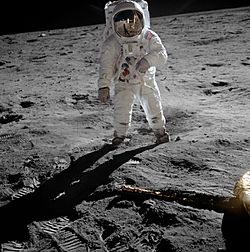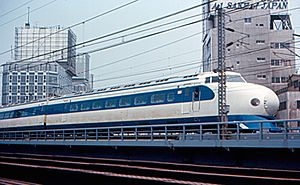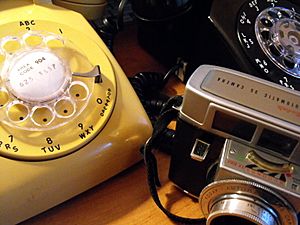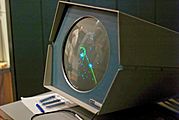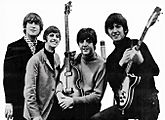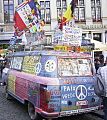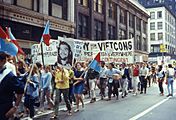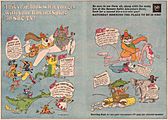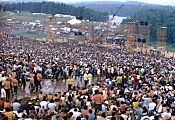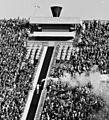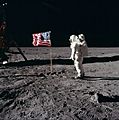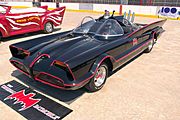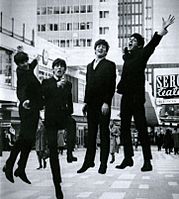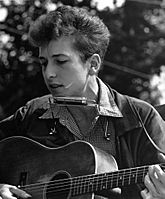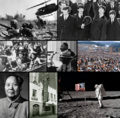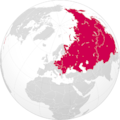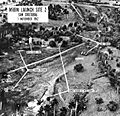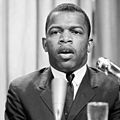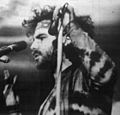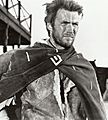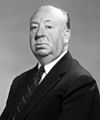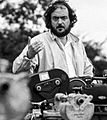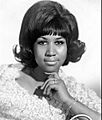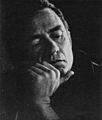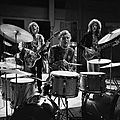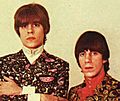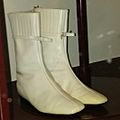1960s facts for kids
| Millennium: | 2nd millennium |
| Centuries: | 19th century – 20th century – 21st century |
| Decades: | 1930s 1940s 1950s – 1960s – 1970s 1980s 1990s |
| Years: | 1960 1961 1962 1963 1964 1965 1966 1967 1968 1969 |
| Categories: | Births – Deaths – Architecture Establishments – Disestablishments |
The 1960s (often called the "Sixties") was a decade that started on January 1, 1960, and ended on December 31, 1969. It was a time of big changes around the world, especially in how people thought and lived. Many new ideas and movements started, challenging old ways.
This decade is famous for its "counterculture," where young people questioned rules about clothing, music, and social manners. It was a time of major changes in civil rights and how people viewed military service and education. Some people saw it as a time of great freedom and new ideas, while others worried about changes to social order. Music exploded with new sounds, from The Beatles leading the "British Invasion" to the thoughtful songs of Bob Dylan. In the United States, it was known as the "cultural decade," and in London, it was called the "Swinging Sixties."
Many countries saw political shifts. In the United States, four presidents served: Dwight D. Eisenhower, John F. Kennedy, Lyndon B. Johnson, and Richard Nixon. After President Kennedy was sadly assassinated in 1963, President Johnson continued his plans, bringing in important laws for civil rights for African Americans and healthcare for older people and those in need.
The world population grew from 3 billion to 3.7 billion people during the 1960s.
Contents
Major World Events and Conflicts
The Cold War and Proxy Conflicts
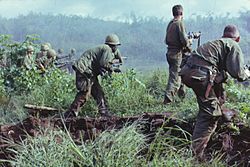
The "Cold War" was a period of tension between the United States and the Soviet Union. It shaped world events throughout the 1960s. Instead of direct fighting, these two superpowers often supported different sides in smaller conflicts around the world, especially in Latin America, Africa, and Asia.
- The Vietnam War (1955–1975) was a major part of the Cold War.
- In 1961, the U.S. sent about 700 military advisors to Vietnam.
- By 1962, this number grew to 12,000 advisors.
- After a naval event in 1964 called the Gulf of Tonkin incident, the U.S. Congress gave President Johnson more power to use military force in Vietnam. This led to a big increase in American involvement.
- By 1966, over 500,000 U.S. troops were sent to Vietnam. This led to many protests back home.
- The Bay of Pigs Invasion (1961) was an attempt by Cuban exiles, supported by the U.S., to overthrow Fidel Castro's government in Cuba. It was not successful.
- The Cuban Missile Crisis (October 1962) was a very tense time when the U.S. and the Soviet Union almost went to war. The Soviet Union had placed missiles in Cuba, close to the U.S. After intense talks, both sides agreed to remove their missiles, avoiding a major conflict.
- Many countries in Africa gained their independence from European rulers during this decade. About 32 countries became independent between 1960 and 1968.
Internal Conflicts and Protests
- In China, the Great Leap Forward ended in 1962, which caused a terrible famine. From 1966 to 1976, the Cultural Revolution began. This was a movement started by Mao Zedong to remove old traditions and capitalist ideas from Chinese society. It led to many arrests, deaths, and the destruction of historical sites.
- The Cultural Revolution in China (1966–1976) caused widespread social and political problems. Mao Zedong believed that "liberal" ideas were spreading and wanted to remove them. Young people formed groups called Red Guards to help with this.
- The Stonewall riots happened in June 1969 in New York City. This was when people from the LGBT community stood up against a police raid at the Stonewall Inn. It is seen as the start of the gay rights movement in the U.S. and around the world.
- In May 1968, big student and worker protests happened in France. These protests were so strong that they almost caused the government to fall.
- The Tlatelolco massacre in Mexico City in October 1968 was a tragic event where government forces killed student and civilian protesters.
New Nuclear Powers
- France tested its first atomic bomb in February 1960 and had a hydrogen bomb by 1968.
- China tested its first atomic bomb in October 1964 and had a hydrogen bomb by 1967.
Economic Changes
The 1960s started with a small economic slowdown from 1960 to 1961. President John F. Kennedy wanted to boost the economy, aiming for 4–6% growth each year. He introduced tax credits for businesses. By the end of the decade, family incomes had grown significantly. The world economy generally did well, with the middle class growing and new technologies becoming more common in homes.
Major Disasters
Natural Disasters
- The 1960 Valdivia earthquake in Chile was the strongest earthquake ever recorded. It caused huge waves that hit the Chilean coast and even reached Hawaii.
- The 1963 Skopje earthquake in Macedonia killed over 1,070 people and destroyed most of the city.
- In 1963, the Vajont dam disaster in Italy caused a flood that killed about 2,000 people.
- The Good Friday earthquake in Alaska was the strongest ever recorded in the U.S., killing 143 people.
- In 1969, the Cuyahoga River in Ohio caught fire due to pollution. This event helped lead to new laws to control water pollution.
Other Accidents
- In December 1960, two planes collided over New York City, killing 134 people.
- In February 1961, Sabena Flight 548 crashed in Belgium, killing all 72 people on board, including the entire U.S. figure skating team.
- In March 1962, Flying Tiger Line Flight 739 disappeared over the Pacific, with all 107 people presumed dead. The cause is still a mystery.
- In June 1962, Air France Flight 007 crashed on takeoff from Paris, killing 130 people.
Social and Political Movements
Counterculture and Youth Revolution
The second half of the 1960s saw young people rebel against traditional rules and mainstream ideas. This led to a "counterculture" movement, especially in the Western world. It started in the U.S. as a reaction to the strictness of the 1950s and the country's involvement in the Vietnam War. Young people in this movement were often called hippies. They pushed for more freedom and rights for women and minorities.
Anti-War Movement
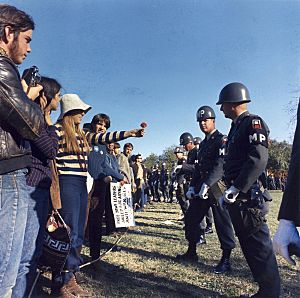
The Vietnam War led to a huge anti-war movement in the United States. As the war continued and more American soldiers died, protests grew. Students on college campuses were a strong voice against the war. The movement also protested the "Draft," which forced young men to join the military. A common saying was: "If you're old enough to die for your country, you're old enough to vote."
Civil Rights Movement
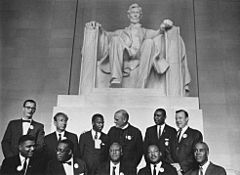
From the mid-1950s to the late 1960s, African Americans in the U.S. fought to end racial discrimination and gain voting rights. This movement used peaceful protests like civil disobedience and nonviolent action.
- The Montgomery Bus Boycott (1955–1956) in Alabama was a successful protest against bus segregation.
- "Sit-ins" like the Greensboro sit-ins (1960) in North Carolina challenged segregated public places.
- Marches, such as the Selma to Montgomery marches (1965) in Alabama, drew attention to voting rights.
Important laws passed during this time included:
- The Civil Rights Act of 1964, which banned discrimination based on race, color, religion, or national origin in jobs and public places.
- The Voting Rights Act of 1965, which protected voting rights for all.
- The Fair Housing Act of 1968, which banned discrimination in housing.
Hispanic and Chicano Movement
Mexican Americans and other Hispanic groups in the U.S. also fought against racial discrimination. The Chicano Movement worked to end negative stereotypes and promote Mexican-American culture. They pushed for official bilingualism in government. Organizations like the League of United Latin American Citizens (formed in 1929) and the American GI Forum (formed by Mexican American veterans after World War II) were important.
Key legal victories included:
- The 1947 Mendez v. Westminster Supreme Court ruling, which said that separating children of "Mexican and Latin descent" was against the law.
- The 1954 Hernandez v. Texas ruling, which said that Mexican Americans had equal protection under the 14th Amendment.
The Mexican American Legal Defense and Educational Fund (MALDEF) was founded in 1968 to fight for civil rights.
Second-Wave Feminism
A new wave of feminism gained strength in the early 1960s. While earlier feminists focused on voting rights, this "second wave" aimed to change cultural and social norms that limited women. At the time, women were often expected to stay home and were excluded from many jobs.
- A U.S. government report found widespread discrimination against women in the workplace.
- This led to new laws like the Equal Pay Act of 1963, which aimed to ensure equal pay for equal work.
- In 1963, Betty Friedan's book The Feminine Mystique questioned women's roles in society.
- In 1966, Friedan and other feminists founded the National Organization for Women.
- In 1968, "Women's Liberation" became a common term as women protested for more rights and freedoms.
Gay Rights Movement
Inspired by other civil rights movements, early gay rights activists began to form a movement in the 1960s. They argued that gay people deserved equal rights. The Stonewall riots in June 1969 in New York City were a turning point. For the first time, LGBT people openly resisted a police raid. This event sparked a new period in the gay rights movement, leading to big changes in the years that followed.
Science and Technology Innovations
Space Exploration: The Space Race
The "Space Race" between the United States and the Soviet Union was a major focus of the 1960s.
- On April 12, 1961, Soviet cosmonaut Yuri Gagarin became the first man in outer space.
- In May 1961, U.S. President Kennedy set the goal of landing a person on the Moon by the end of the decade.
- In June 1963, Valentina Tereshkova became the first woman in space.
- The Soviet Union sent the first probes to Venus and the Moon.
- On December 21, 1968, the Apollo 8 crew took the first picture of the entire Earth from space.
- On July 20, 1969, the Apollo 11 mission successfully landed the first humans, Neil Armstrong and Buzz Aldrin, on the Moon. This achieved President Kennedy's goal.
Other Scientific Discoveries
- 1963: The measles vaccine was released.
- 1964: The Cosmic microwave background was discovered, supporting the Big Bang theory of the universe's origin.
- 1967: The first heart transplant operation was performed in South Africa.
- 1967: The first pulsar (a rapidly spinning neutron star) was discovered.
- The "Green Revolution" made big improvements in farming and food production.
Technological Advancements
- The Shinkansen, the world's first high-speed rail service, began in Japan in 1964.
Automobiles
- American cars became less flashy and more boxy.
- The Ford Mustang, launched in 1964, was a huge success.
- The "Big Three" American carmakers had their best sales ever.
- The modern hatchback car, with a large rear opening, was born in 1965 with the Renault 16.
- Japanese cars like the Toyota Corolla and Datsun 510 started to become popular in Western countries.
Electronics and Communication
- 1960: The first working laser was shown.
- 1962: The first transatlantic satellite broadcast happened via the Telstar satellite.
- 1962: The first computer video game, Spacewar!, was created.
- 1963: Touch-Tone telephones were introduced.
- 1964: The Compact Cassette was introduced, making music more portable.
- 1964: The first successful Minicomputer, the PDP-8, was sold.
- 1964: The programming language BASIC was created, making computers easier to use.
- 1968: The first public demonstration of the computer mouse, video conferencing, and hypertext took place.
- 1969: ARPANET, an early version of the Internet, was introduced.
Popular Culture
-
Spacewar! was one of the first influential computer games.
-
TV shows like Doctor Who and Star Trek: The Original Series were popular.
-
The Beatles were one of the most popular bands in history.
-
Bob Dylan was a very influential songwriter.
-
Peace symbols and flowers were popular with the counterculture.
-
Anti-war movements were a big part of 1960s popular culture.
-
Hanna-Barbera cartoons like Scooby-Doo were popular.
-
Crowds at the Woodstock Festival in 1969.
-
The 1964 Summer Olympics were held in Tokyo.
-
The 1960s were the height of the Space Age.
-
Superhero TV series like Batman were popular.
The counterculture movement was very important in the second half of the decade. Famous events included the Summer of Love in San Francisco in 1967 and the Woodstock Festival in 1969.
Music: A Revolution in Sound
The 1960s brought huge changes to music. After the early rock 'n' roll stars faded, new sounds emerged.
- Girl groups like the Supremes became very popular with songs about teenage life.
- Surf rock emerged from Southern California, with The Beach Boys leading the way with songs about beaches and surfing.
- The American folk music revival introduced artists like Bob Dylan and Joan Baez, who sang poetic and often protest songs.
The biggest change came with the "British Invasion."
- The Beatles arrived in America in 1964 and became incredibly popular, starting "Beatlemania." They changed rock music with their creative songs and studio work.
- Other British bands like the Rolling Stones and the Kinks also became famous.
- Guitarist Jimi Hendrix changed how electric guitar was played, bringing a new energy to rock.
Music also shifted from focusing on single songs to entire albums. Artists like the Beatles and Bob Dylan created albums with deeper themes and more complex arrangements. Blues music continued to grow, and country music gained popularity, especially on the West Coast.
Film: Breaking Boundaries
The 1960s was a time of big changes in movies. Films started to challenge social rules and became more dramatic. This period led to the "New Hollywood" era, which changed the film industry.
- Some of the most popular films included The Sound of Music, 2001: A Space Odyssey, Psycho, and The Graduate.
- Japanese director Akira Kurosawa made influential samurai films like Yojimbo, which inspired Westerns like A Fistful of Dollars starring Clint Eastwood.
- Animated films like Walt Disney's One Hundred and One Dalmatians and The Jungle Book were also popular.
Important changes in the film industry included:
- The end of strict rules about what could be shown in movies.
- The rise of "art house" films, which were more artistic and experimental.
- The move to making all Hollywood films in color.
Television: A Growing Influence
Television became a huge part of daily life in the 1960s.
- Popular TV series included Doctor Who, Star Trek, The Flintstones, The Beverly Hillbillies, and Batman.
- Some shows, like The Smothers Brothers Comedy Hour, became controversial by making fun of leaders and questioning the Vietnam War.
- Walt Disney, the famous founder of The Walt Disney Company, passed away in 1966.
Fashion: Bold and Expressive
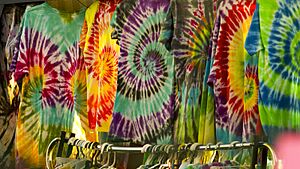
Fashion in the 1960s was exciting and new.
- The Beatles had a huge impact on young men's styles, popularizing the mop-top haircut and Beatle boots.
- The hippie movement influenced clothing with bell-bottom jeans, tie-dye fabrics, and paisley prints.
- The bikini became popular after being shown in the film Beach Party in 1963.
- Mary Quant made the miniskirt famous, which was a huge trend for young women.
- Hairstyles changed too, from neat, short cuts to longer styles and the afro for African Americans.
Sports: New Heroes and Events
Olympics
Six Olympic Games were held during the 1960s:
- 1960 Summer Olympics in Rome, Italy
- 1960 Winter Olympics in Squaw Valley, California, United States
- 1964 Summer Olympics in Tokyo, Japan
- 1964 Winter Olympics in Innsbruck, Austria
- 1968 Summer Olympics in Mexico City, Mexico
- 1968 Winter Olympics in Grenoble, France
Football (Soccer)
Two FIFA World Cups took place:
- 1962 FIFA World Cup in Chile, won by Brazil.
- 1966 FIFA World Cup in England, won by England.
Baseball
Major League Baseball expanded, adding new teams like the Los Angeles Angels and the New York Mets. By 1969, the New York Mets, a new team, won the World Series.
Basketball
The NBA was dominated by the Boston Celtics, who won many championships with players like Bill Russell. College basketball also saw the UCLA Bruins win many titles.
Disc Sports (Frisbee)
Alternative sports using the Frisbee began to grow in the mid-1960s. As young people looked for new ways to have fun, sports like disc ultimate and disc golf started to become popular.
Images for kids
-
Clockwise from top left: U.S. soldiers during the Vietnam War; the Beatles; the 1969 Woodstock Festival; Neil Armstrong and Buzz Aldrin walk on the Moon; the Stonewall Inn; China's Mao Zedong initiates the Great Leap Forward plan and the Cultural Revolution; John F. Kennedy is assassinated in 1963; Martin Luther King Jr. makes his famous "I Have a Dream" speech.
See also
 In Spanish: Años 1960 para niños
In Spanish: Años 1960 para niños


